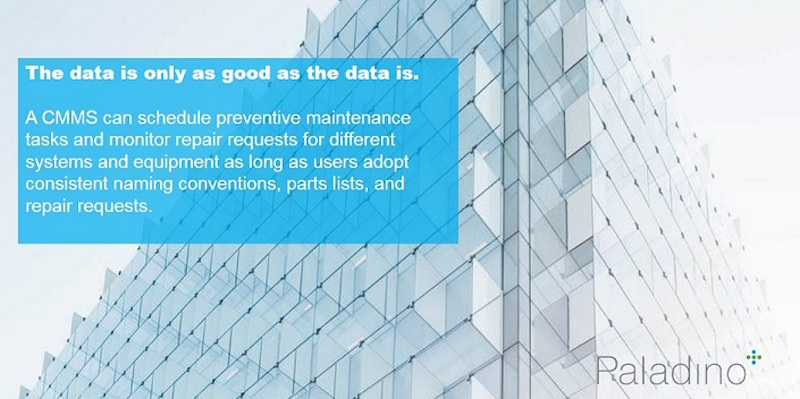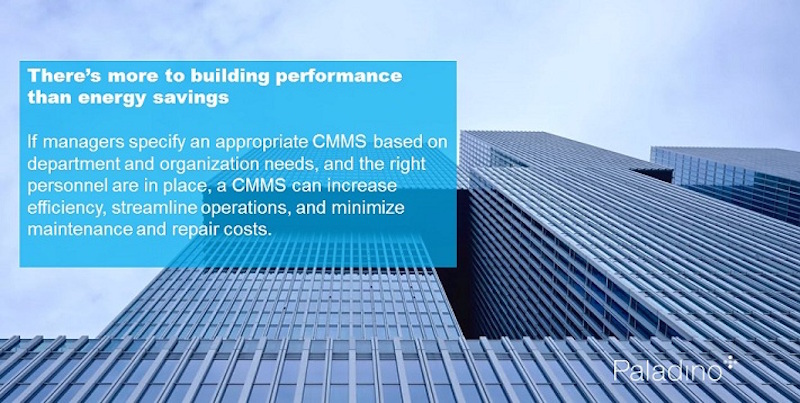One of the cornerstones of green building is energy management, and our commissioning team particularly focuses on the energy consumption and operations of building equipment.
But energy savings is just one metric that building maintenance professionals care about. In addition to real-time performance management through solutions like Clarity, our clients also rely heavily on Enterprise Asset Management (EAM) and Computerized Maintenance Management Systems (CMMS) software. For this post, I’ll use the CMMS acronym to cover both technologies.
Maintenance and engineering managers need to monitor the condition of their equipment and the workloads of front-line technicians. Luckily, spreadsheets of the past have given way to advanced software that automates information analysis and greatly reduces the management effort.
If managers specify an appropriate CMMS based on department and organization needs, and the right personnel are in place, a CMMS can increase efficiency, streamline operations, and minimize maintenance and repair costs.
Managers are expected to allocate capital funding to replace old or malfunctioning equipment, in many cases years in advance. A CMMS that shows equipment age, projected lifespan, and maintenance history can help. With this data, managers can conduct a condition assessment and determine the accumulated cost of maintenance and repair compared with the cost of replacement for a piece of equipment.
This type of quantitative analysis is helpful, although it might not be enough to determine whether a piece of equipment should be replaced. For example, a 10-year-old boiler might be past its projected lifespan. But what if the tubes show no signs of rust or damage, and the unit delivers close-to-nominal efficiency? Further, what if it hasn’t required substantial repair to keep it running? In that case, there’s no reason to replace it. On the other hand, what if you have a three-year-old toilet exhaust fan that still runs but its shroud is rusted and has needed several repairs? That’s a good candidate for replacement.
A well-developed CMMS enables managers to make accurate cost comparison and repair projections to make capital planning easier, which streamlines operations and minimizes costs.
Managers can also track the actual cost of a repair or a PM, including wages, parts, and lost operating costs of the equipment with a CMMS. If a CMMS contains the parameters to be measured, a manager can verify that the facility is property staffed and adjust if necessary. Managers can also perform cost analyses to determine whether it is better to retain tradespeople or to outsource certain maintenance and repairs to a contractor.

Like so many systems, the data is only as good as the data is. A CMMS can schedule preventive maintenance tasks and monitor repair requests for different systems and equipment as long as users adopt consistent naming conventions, parts lists, and repair requests.
A well-trained operator or experienced manager can use the CMMS to significantly increase their department’s efficiency and productivity, streamline operations, and decrease operational and maintenance costs. As time goes on and CMMS technology advances, upgrading to a new version of a certain CMMS will be simple and quick. Savvy managers do everything possible to benefit from the power of a CMMS and use its features to make their jobs easier, their departments more effective, and to reduce operational costs.
More from Author
Paladino | Jan 10, 2022
The future of regenerative building is performance-based
Why measuring performance results is so critical, but also easier said than done.
Paladino | May 26, 2021
Injecting embodied carbon capability into the integrated design and construction process
Embodied carbon is defined as the carbon footprint of a material, and is expressed in metric tons of CO2e.
Paladino | May 12, 2021
Climate modeling for a resilient business and future
This post explores changes that developers and their teams need to make to their risk and resilience strategies by climate modeling for climate change.
Paladino | Apr 26, 2021
Building performance requirements are coming: Are you ready?
Building Performance Requirements are trending nationwide and are likely coming to a county near you.
Paladino | Feb 8, 2021
Six lessons learned from our first Fitwel Viral Response Module certification
The Fitwel Viral Response Module is one of several frameworks that real estate owners and operators can use to obtain third-party certification for their efforts ensuring their properties are ready for a safer and healthier return to work.
Paladino | Jan 14, 2021
Shift your energy to carbon
Now is the right and necessary time for the commercial real estate industry to shift its environmental strategy from just energy, a carbon contributor, to carbon itself.
Paladino | Nov 13, 2020
5 tips when designing for daylight
Daylight modeling is a tool to examine how daylight interacts with a building, and how that natural light behaves within interior spaces.
Paladino | Jul 16, 2020
COVID readiness: IWBI and USGBC seek to help businesses quantify risk
In an effort to address the risks of COVID-19 at the building scale, USGBC and IWBI have analyzed existing certification guidelines and drafted new, relevant content.
Paladino | Jun 5, 2020
3 strategies to improve the wellness of building systems and gain tenant trust
Three operational issues that must be prioritized for every building in order to achieve tenant trust are air quality/ventilation, relative humidity, and building commissioning.
















